HI6008 Research: Cultural Diversity Impact on Team Performance
VerifiedAdded on 2023/06/04
|10
|2649
|128
Report
AI Summary
This research proposal explores the impact of cultural diversity on team performance, addressing factors like communication, creativity, and conflict. It reviews existing literature, identifies research questions, and outlines a mixed-methods approach using both qualitative and quantitative data collection. The proposal details the research design, including sampling methods, data analysis techniques, and considerations for reliability and validity. It also acknowledges potential limitations and provides a time plan for the research. The aim is to understand how cultural diversity influences team dynamics and to identify strategies for improving team performance in diverse settings. Desklib provides access to similar research papers and study tools.
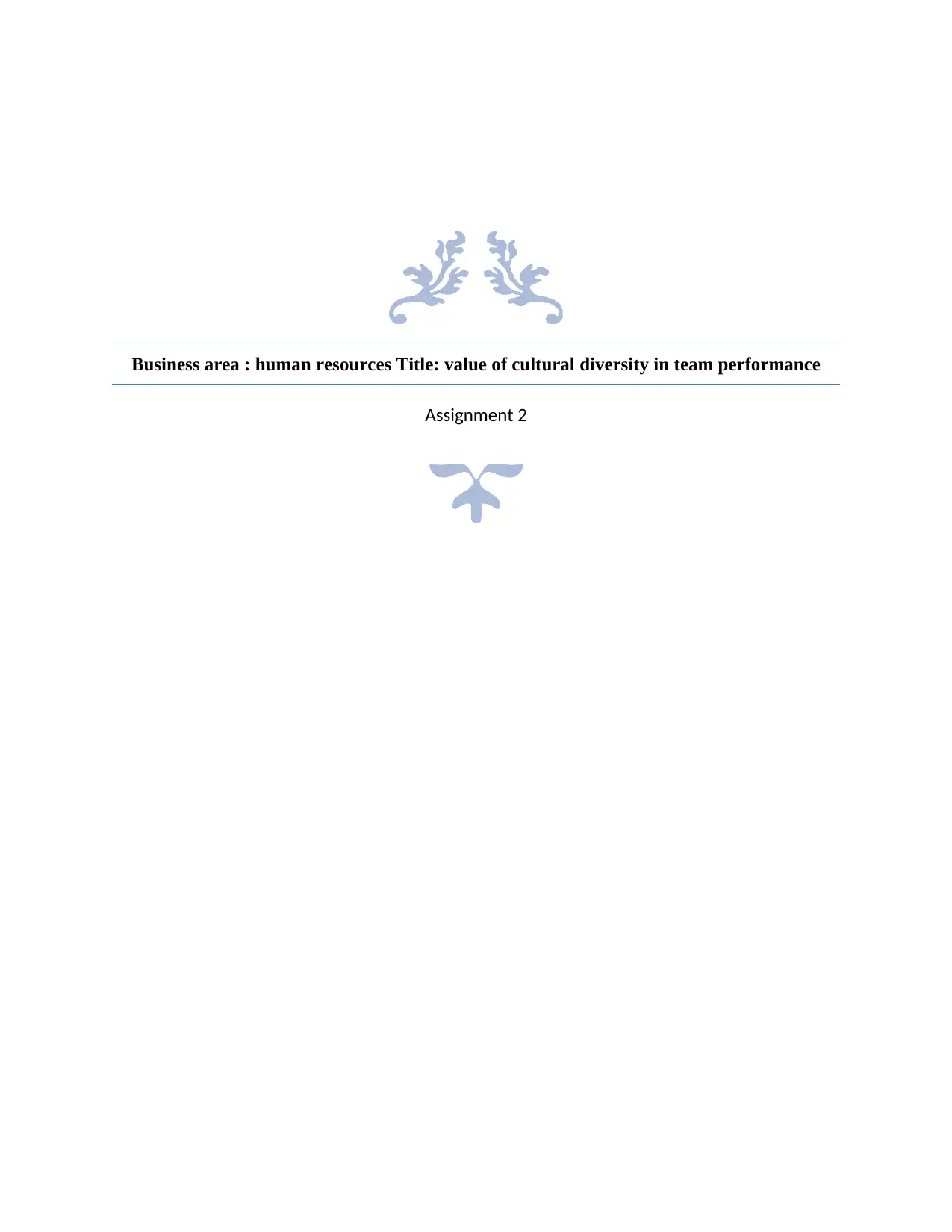
Business area : human resources Title: value of cultural diversity in team performance
Assignment 2
Assignment 2
Paraphrase This Document
Need a fresh take? Get an instant paraphrase of this document with our AI Paraphraser
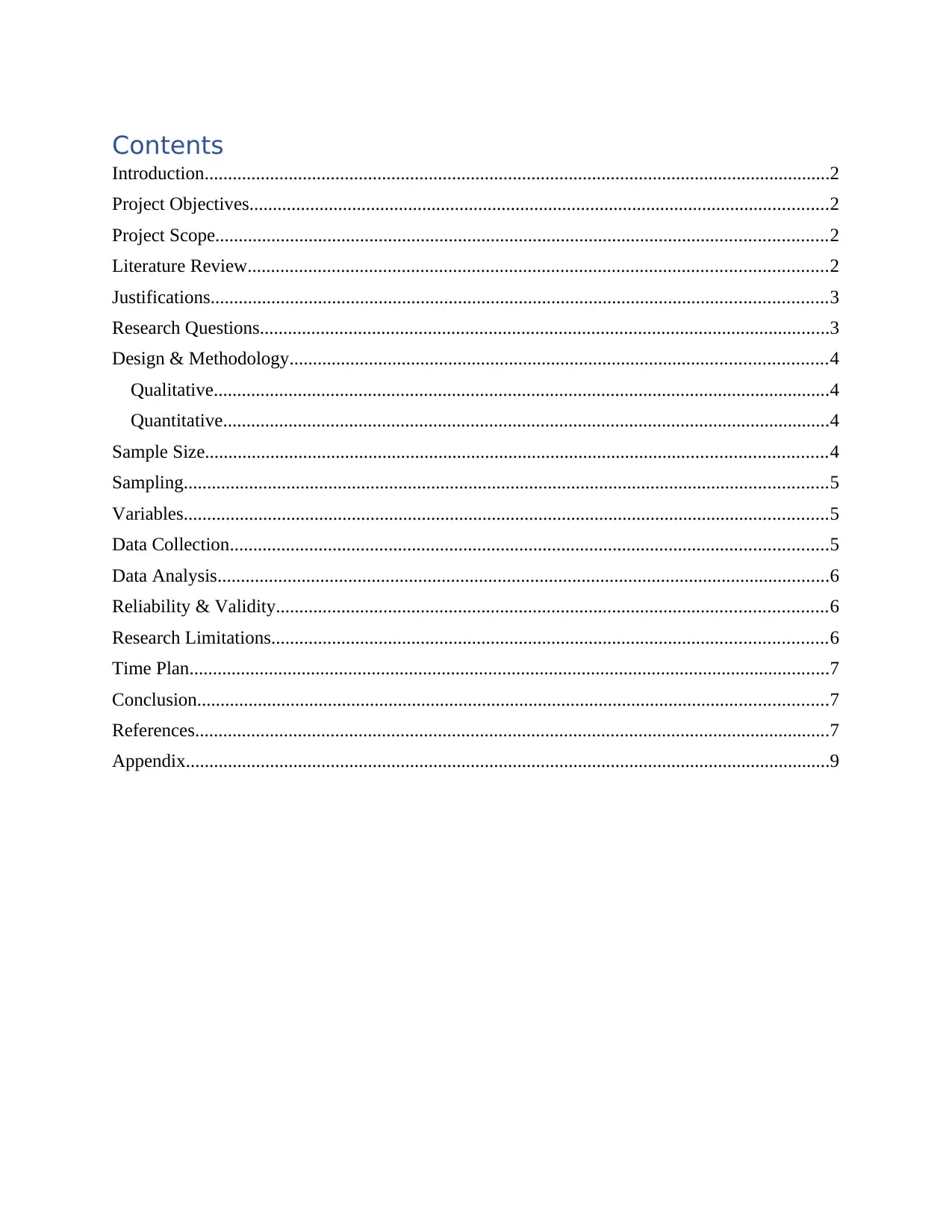
Contents
Introduction......................................................................................................................................2
Project Objectives............................................................................................................................2
Project Scope...................................................................................................................................2
Literature Review............................................................................................................................2
Justifications....................................................................................................................................3
Research Questions..........................................................................................................................3
Design & Methodology...................................................................................................................4
Qualitative....................................................................................................................................4
Quantitative..................................................................................................................................4
Sample Size.....................................................................................................................................4
Sampling..........................................................................................................................................5
Variables..........................................................................................................................................5
Data Collection................................................................................................................................5
Data Analysis...................................................................................................................................6
Reliability & Validity......................................................................................................................6
Research Limitations.......................................................................................................................6
Time Plan.........................................................................................................................................7
Conclusion.......................................................................................................................................7
References........................................................................................................................................7
Appendix..........................................................................................................................................9
Introduction......................................................................................................................................2
Project Objectives............................................................................................................................2
Project Scope...................................................................................................................................2
Literature Review............................................................................................................................2
Justifications....................................................................................................................................3
Research Questions..........................................................................................................................3
Design & Methodology...................................................................................................................4
Qualitative....................................................................................................................................4
Quantitative..................................................................................................................................4
Sample Size.....................................................................................................................................4
Sampling..........................................................................................................................................5
Variables..........................................................................................................................................5
Data Collection................................................................................................................................5
Data Analysis...................................................................................................................................6
Reliability & Validity......................................................................................................................6
Research Limitations.......................................................................................................................6
Time Plan.........................................................................................................................................7
Conclusion.......................................................................................................................................7
References........................................................................................................................................7
Appendix..........................................................................................................................................9
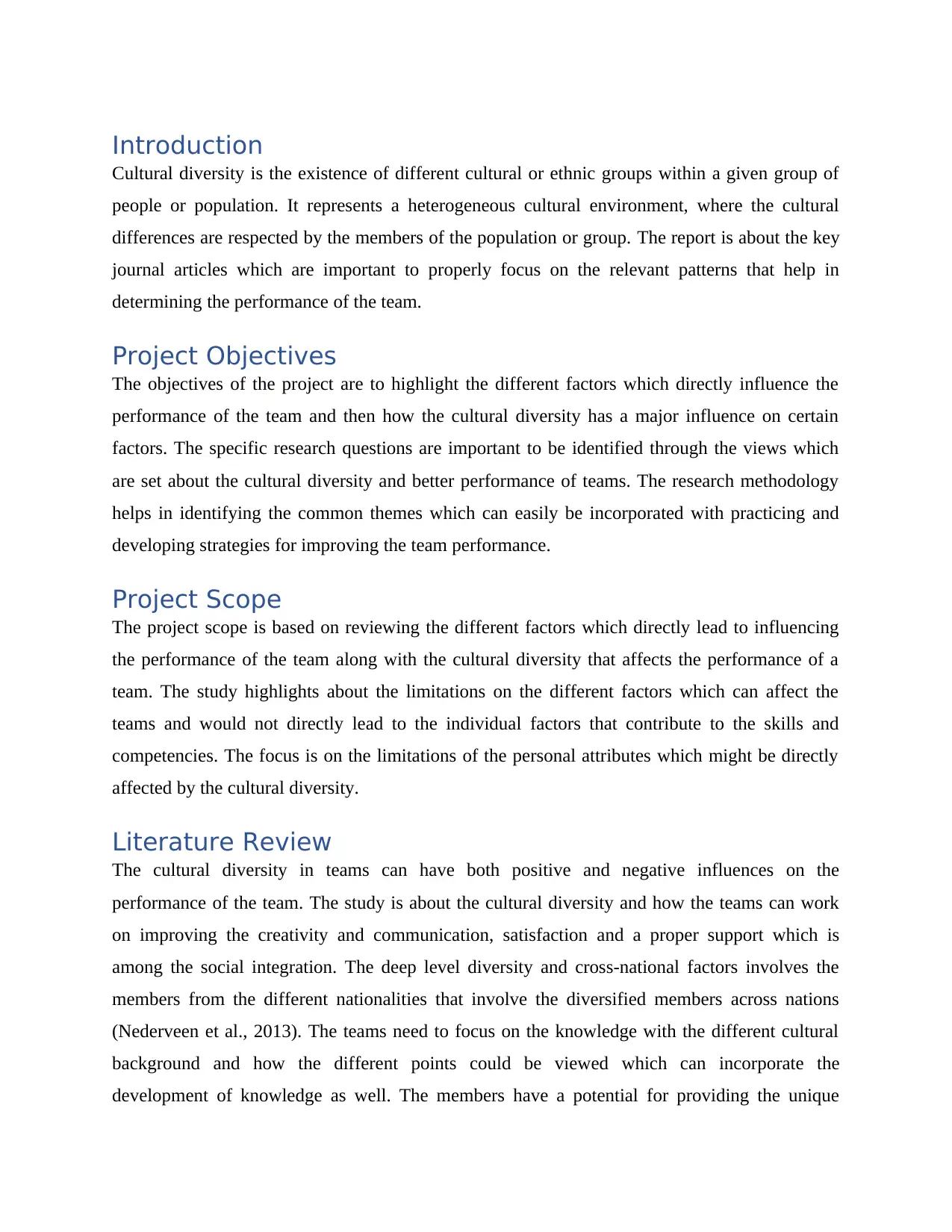
Introduction
Cultural diversity is the existence of different cultural or ethnic groups within a given group of
people or population. It represents a heterogeneous cultural environment, where the cultural
differences are respected by the members of the population or group. The report is about the key
journal articles which are important to properly focus on the relevant patterns that help in
determining the performance of the team.
Project Objectives
The objectives of the project are to highlight the different factors which directly influence the
performance of the team and then how the cultural diversity has a major influence on certain
factors. The specific research questions are important to be identified through the views which
are set about the cultural diversity and better performance of teams. The research methodology
helps in identifying the common themes which can easily be incorporated with practicing and
developing strategies for improving the team performance.
Project Scope
The project scope is based on reviewing the different factors which directly lead to influencing
the performance of the team along with the cultural diversity that affects the performance of a
team. The study highlights about the limitations on the different factors which can affect the
teams and would not directly lead to the individual factors that contribute to the skills and
competencies. The focus is on the limitations of the personal attributes which might be directly
affected by the cultural diversity.
Literature Review
The cultural diversity in teams can have both positive and negative influences on the
performance of the team. The study is about the cultural diversity and how the teams can work
on improving the creativity and communication, satisfaction and a proper support which is
among the social integration. The deep level diversity and cross-national factors involves the
members from the different nationalities that involve the diversified members across nations
(Nederveen et al., 2013). The teams need to focus on the knowledge with the different cultural
background and how the different points could be viewed which can incorporate the
development of knowledge as well. The members have a potential for providing the unique
Cultural diversity is the existence of different cultural or ethnic groups within a given group of
people or population. It represents a heterogeneous cultural environment, where the cultural
differences are respected by the members of the population or group. The report is about the key
journal articles which are important to properly focus on the relevant patterns that help in
determining the performance of the team.
Project Objectives
The objectives of the project are to highlight the different factors which directly influence the
performance of the team and then how the cultural diversity has a major influence on certain
factors. The specific research questions are important to be identified through the views which
are set about the cultural diversity and better performance of teams. The research methodology
helps in identifying the common themes which can easily be incorporated with practicing and
developing strategies for improving the team performance.
Project Scope
The project scope is based on reviewing the different factors which directly lead to influencing
the performance of the team along with the cultural diversity that affects the performance of a
team. The study highlights about the limitations on the different factors which can affect the
teams and would not directly lead to the individual factors that contribute to the skills and
competencies. The focus is on the limitations of the personal attributes which might be directly
affected by the cultural diversity.
Literature Review
The cultural diversity in teams can have both positive and negative influences on the
performance of the team. The study is about the cultural diversity and how the teams can work
on improving the creativity and communication, satisfaction and a proper support which is
among the social integration. The deep level diversity and cross-national factors involves the
members from the different nationalities that involve the diversified members across nations
(Nederveen et al., 2013). The teams need to focus on the knowledge with the different cultural
background and how the different points could be viewed which can incorporate the
development of knowledge as well. The members have a potential for providing the unique
⊘ This is a preview!⊘
Do you want full access?
Subscribe today to unlock all pages.

Trusted by 1+ million students worldwide
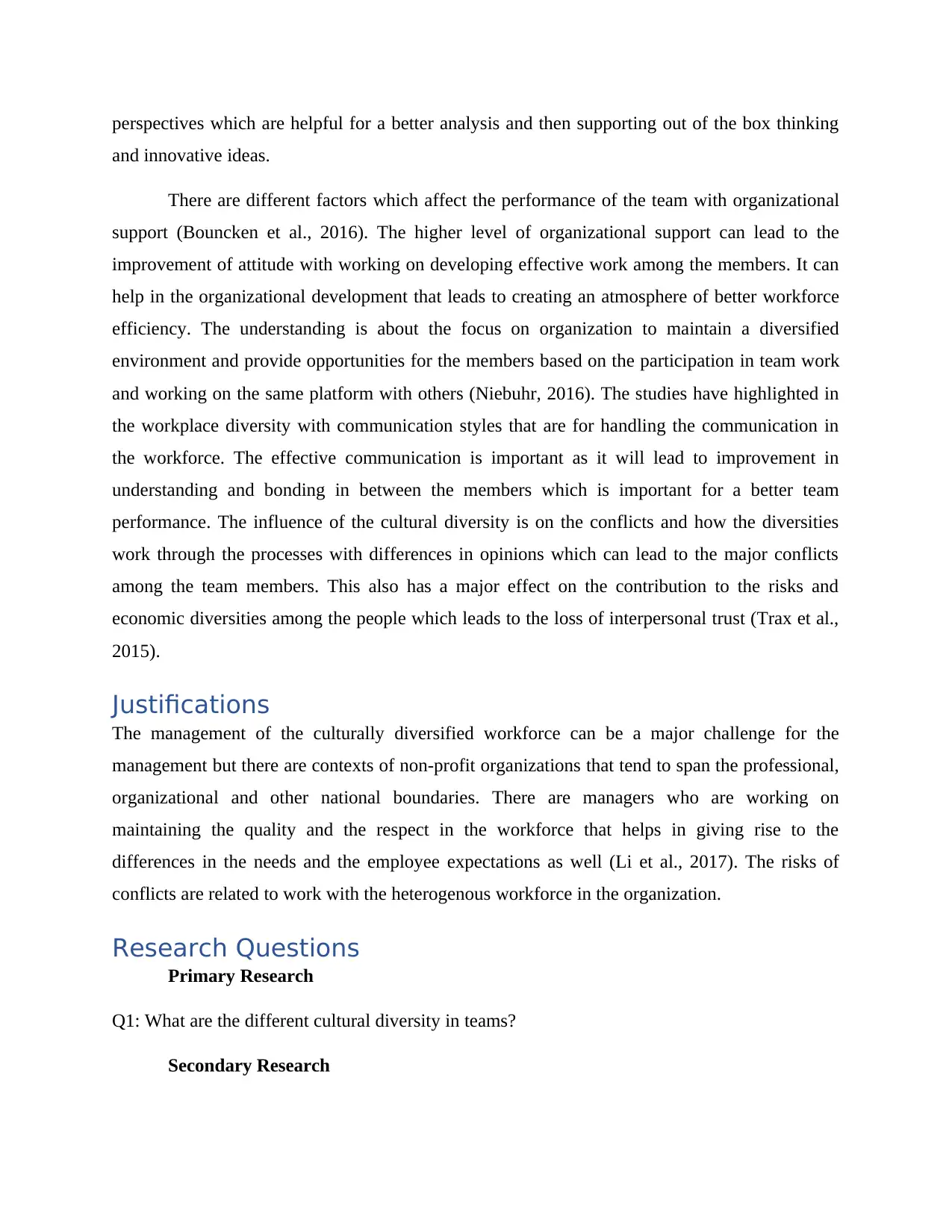
perspectives which are helpful for a better analysis and then supporting out of the box thinking
and innovative ideas.
There are different factors which affect the performance of the team with organizational
support (Bouncken et al., 2016). The higher level of organizational support can lead to the
improvement of attitude with working on developing effective work among the members. It can
help in the organizational development that leads to creating an atmosphere of better workforce
efficiency. The understanding is about the focus on organization to maintain a diversified
environment and provide opportunities for the members based on the participation in team work
and working on the same platform with others (Niebuhr, 2016). The studies have highlighted in
the workplace diversity with communication styles that are for handling the communication in
the workforce. The effective communication is important as it will lead to improvement in
understanding and bonding in between the members which is important for a better team
performance. The influence of the cultural diversity is on the conflicts and how the diversities
work through the processes with differences in opinions which can lead to the major conflicts
among the team members. This also has a major effect on the contribution to the risks and
economic diversities among the people which leads to the loss of interpersonal trust (Trax et al.,
2015).
Justifications
The management of the culturally diversified workforce can be a major challenge for the
management but there are contexts of non-profit organizations that tend to span the professional,
organizational and other national boundaries. There are managers who are working on
maintaining the quality and the respect in the workforce that helps in giving rise to the
differences in the needs and the employee expectations as well (Li et al., 2017). The risks of
conflicts are related to work with the heterogenous workforce in the organization.
Research Questions
Primary Research
Q1: What are the different cultural diversity in teams?
Secondary Research
and innovative ideas.
There are different factors which affect the performance of the team with organizational
support (Bouncken et al., 2016). The higher level of organizational support can lead to the
improvement of attitude with working on developing effective work among the members. It can
help in the organizational development that leads to creating an atmosphere of better workforce
efficiency. The understanding is about the focus on organization to maintain a diversified
environment and provide opportunities for the members based on the participation in team work
and working on the same platform with others (Niebuhr, 2016). The studies have highlighted in
the workplace diversity with communication styles that are for handling the communication in
the workforce. The effective communication is important as it will lead to improvement in
understanding and bonding in between the members which is important for a better team
performance. The influence of the cultural diversity is on the conflicts and how the diversities
work through the processes with differences in opinions which can lead to the major conflicts
among the team members. This also has a major effect on the contribution to the risks and
economic diversities among the people which leads to the loss of interpersonal trust (Trax et al.,
2015).
Justifications
The management of the culturally diversified workforce can be a major challenge for the
management but there are contexts of non-profit organizations that tend to span the professional,
organizational and other national boundaries. There are managers who are working on
maintaining the quality and the respect in the workforce that helps in giving rise to the
differences in the needs and the employee expectations as well (Li et al., 2017). The risks of
conflicts are related to work with the heterogenous workforce in the organization.
Research Questions
Primary Research
Q1: What are the different cultural diversity in teams?
Secondary Research
Paraphrase This Document
Need a fresh take? Get an instant paraphrase of this document with our AI Paraphraser
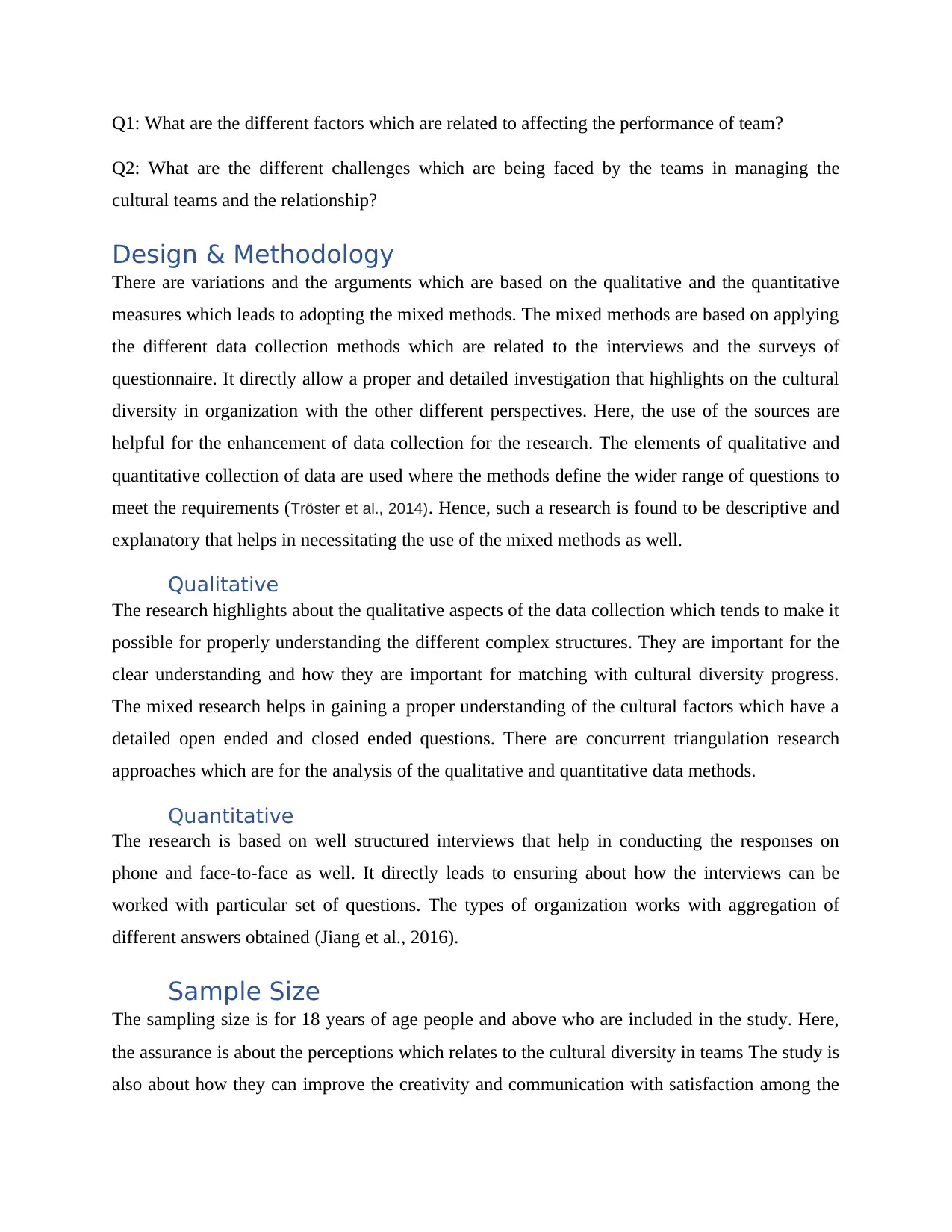
Q1: What are the different factors which are related to affecting the performance of team?
Q2: What are the different challenges which are being faced by the teams in managing the
cultural teams and the relationship?
Design & Methodology
There are variations and the arguments which are based on the qualitative and the quantitative
measures which leads to adopting the mixed methods. The mixed methods are based on applying
the different data collection methods which are related to the interviews and the surveys of
questionnaire. It directly allow a proper and detailed investigation that highlights on the cultural
diversity in organization with the other different perspectives. Here, the use of the sources are
helpful for the enhancement of data collection for the research. The elements of qualitative and
quantitative collection of data are used where the methods define the wider range of questions to
meet the requirements (Tröster et al., 2014). Hence, such a research is found to be descriptive and
explanatory that helps in necessitating the use of the mixed methods as well.
Qualitative
The research highlights about the qualitative aspects of the data collection which tends to make it
possible for properly understanding the different complex structures. They are important for the
clear understanding and how they are important for matching with cultural diversity progress.
The mixed research helps in gaining a proper understanding of the cultural factors which have a
detailed open ended and closed ended questions. There are concurrent triangulation research
approaches which are for the analysis of the qualitative and quantitative data methods.
Quantitative
The research is based on well structured interviews that help in conducting the responses on
phone and face-to-face as well. It directly leads to ensuring about how the interviews can be
worked with particular set of questions. The types of organization works with aggregation of
different answers obtained (Jiang et al., 2016).
Sample Size
The sampling size is for 18 years of age people and above who are included in the study. Here,
the assurance is about the perceptions which relates to the cultural diversity in teams The study is
also about how they can improve the creativity and communication with satisfaction among the
Q2: What are the different challenges which are being faced by the teams in managing the
cultural teams and the relationship?
Design & Methodology
There are variations and the arguments which are based on the qualitative and the quantitative
measures which leads to adopting the mixed methods. The mixed methods are based on applying
the different data collection methods which are related to the interviews and the surveys of
questionnaire. It directly allow a proper and detailed investigation that highlights on the cultural
diversity in organization with the other different perspectives. Here, the use of the sources are
helpful for the enhancement of data collection for the research. The elements of qualitative and
quantitative collection of data are used where the methods define the wider range of questions to
meet the requirements (Tröster et al., 2014). Hence, such a research is found to be descriptive and
explanatory that helps in necessitating the use of the mixed methods as well.
Qualitative
The research highlights about the qualitative aspects of the data collection which tends to make it
possible for properly understanding the different complex structures. They are important for the
clear understanding and how they are important for matching with cultural diversity progress.
The mixed research helps in gaining a proper understanding of the cultural factors which have a
detailed open ended and closed ended questions. There are concurrent triangulation research
approaches which are for the analysis of the qualitative and quantitative data methods.
Quantitative
The research is based on well structured interviews that help in conducting the responses on
phone and face-to-face as well. It directly leads to ensuring about how the interviews can be
worked with particular set of questions. The types of organization works with aggregation of
different answers obtained (Jiang et al., 2016).
Sample Size
The sampling size is for 18 years of age people and above who are included in the study. Here,
the assurance is about the perceptions which relates to the cultural diversity in teams The study is
also about how they can improve the creativity and communication with satisfaction among the
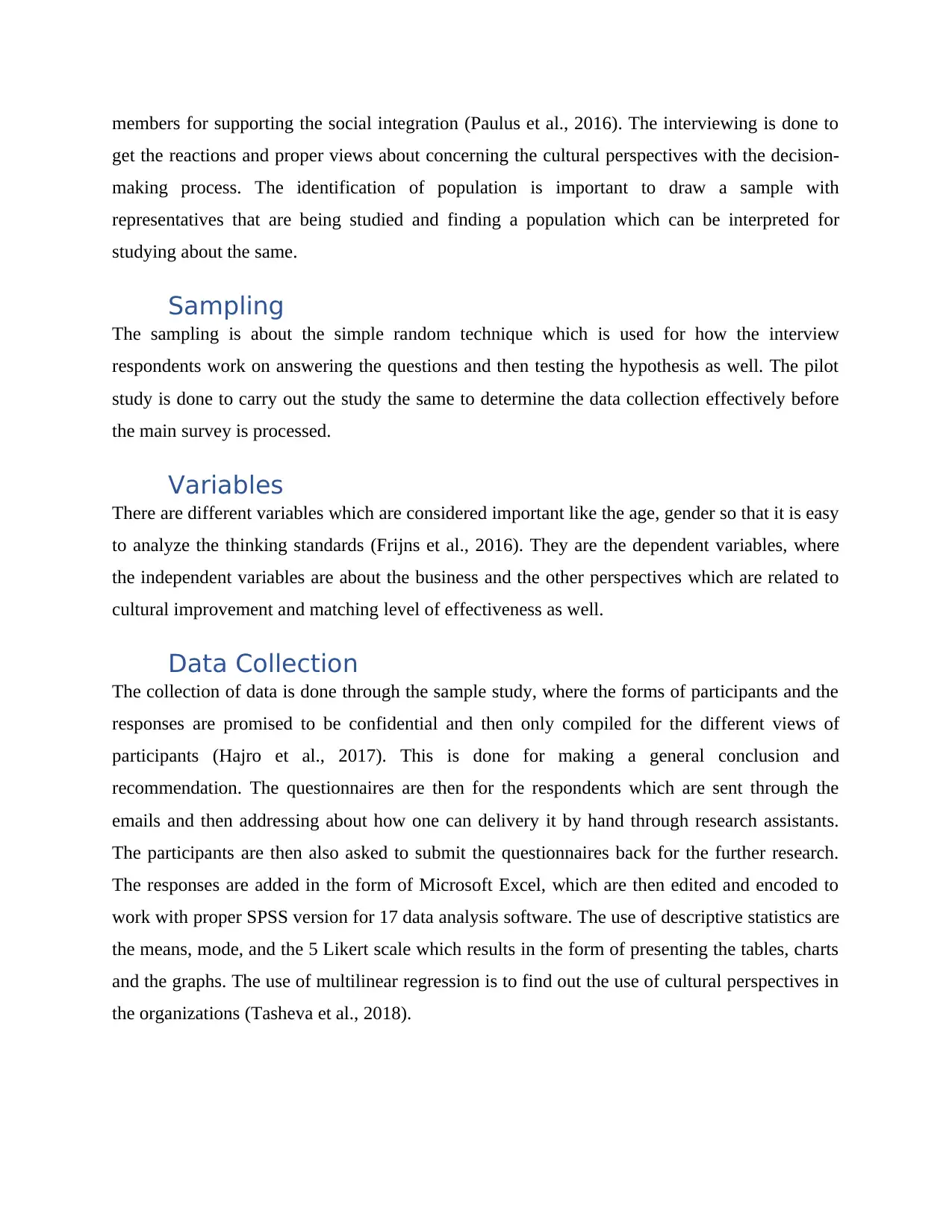
members for supporting the social integration (Paulus et al., 2016). The interviewing is done to
get the reactions and proper views about concerning the cultural perspectives with the decision-
making process. The identification of population is important to draw a sample with
representatives that are being studied and finding a population which can be interpreted for
studying about the same.
Sampling
The sampling is about the simple random technique which is used for how the interview
respondents work on answering the questions and then testing the hypothesis as well. The pilot
study is done to carry out the study the same to determine the data collection effectively before
the main survey is processed.
Variables
There are different variables which are considered important like the age, gender so that it is easy
to analyze the thinking standards (Frijns et al., 2016). They are the dependent variables, where
the independent variables are about the business and the other perspectives which are related to
cultural improvement and matching level of effectiveness as well.
Data Collection
The collection of data is done through the sample study, where the forms of participants and the
responses are promised to be confidential and then only compiled for the different views of
participants (Hajro et al., 2017). This is done for making a general conclusion and
recommendation. The questionnaires are then for the respondents which are sent through the
emails and then addressing about how one can delivery it by hand through research assistants.
The participants are then also asked to submit the questionnaires back for the further research.
The responses are added in the form of Microsoft Excel, which are then edited and encoded to
work with proper SPSS version for 17 data analysis software. The use of descriptive statistics are
the means, mode, and the 5 Likert scale which results in the form of presenting the tables, charts
and the graphs. The use of multilinear regression is to find out the use of cultural perspectives in
the organizations (Tasheva et al., 2018).
get the reactions and proper views about concerning the cultural perspectives with the decision-
making process. The identification of population is important to draw a sample with
representatives that are being studied and finding a population which can be interpreted for
studying about the same.
Sampling
The sampling is about the simple random technique which is used for how the interview
respondents work on answering the questions and then testing the hypothesis as well. The pilot
study is done to carry out the study the same to determine the data collection effectively before
the main survey is processed.
Variables
There are different variables which are considered important like the age, gender so that it is easy
to analyze the thinking standards (Frijns et al., 2016). They are the dependent variables, where
the independent variables are about the business and the other perspectives which are related to
cultural improvement and matching level of effectiveness as well.
Data Collection
The collection of data is done through the sample study, where the forms of participants and the
responses are promised to be confidential and then only compiled for the different views of
participants (Hajro et al., 2017). This is done for making a general conclusion and
recommendation. The questionnaires are then for the respondents which are sent through the
emails and then addressing about how one can delivery it by hand through research assistants.
The participants are then also asked to submit the questionnaires back for the further research.
The responses are added in the form of Microsoft Excel, which are then edited and encoded to
work with proper SPSS version for 17 data analysis software. The use of descriptive statistics are
the means, mode, and the 5 Likert scale which results in the form of presenting the tables, charts
and the graphs. The use of multilinear regression is to find out the use of cultural perspectives in
the organizations (Tasheva et al., 2018).
⊘ This is a preview!⊘
Do you want full access?
Subscribe today to unlock all pages.

Trusted by 1+ million students worldwide
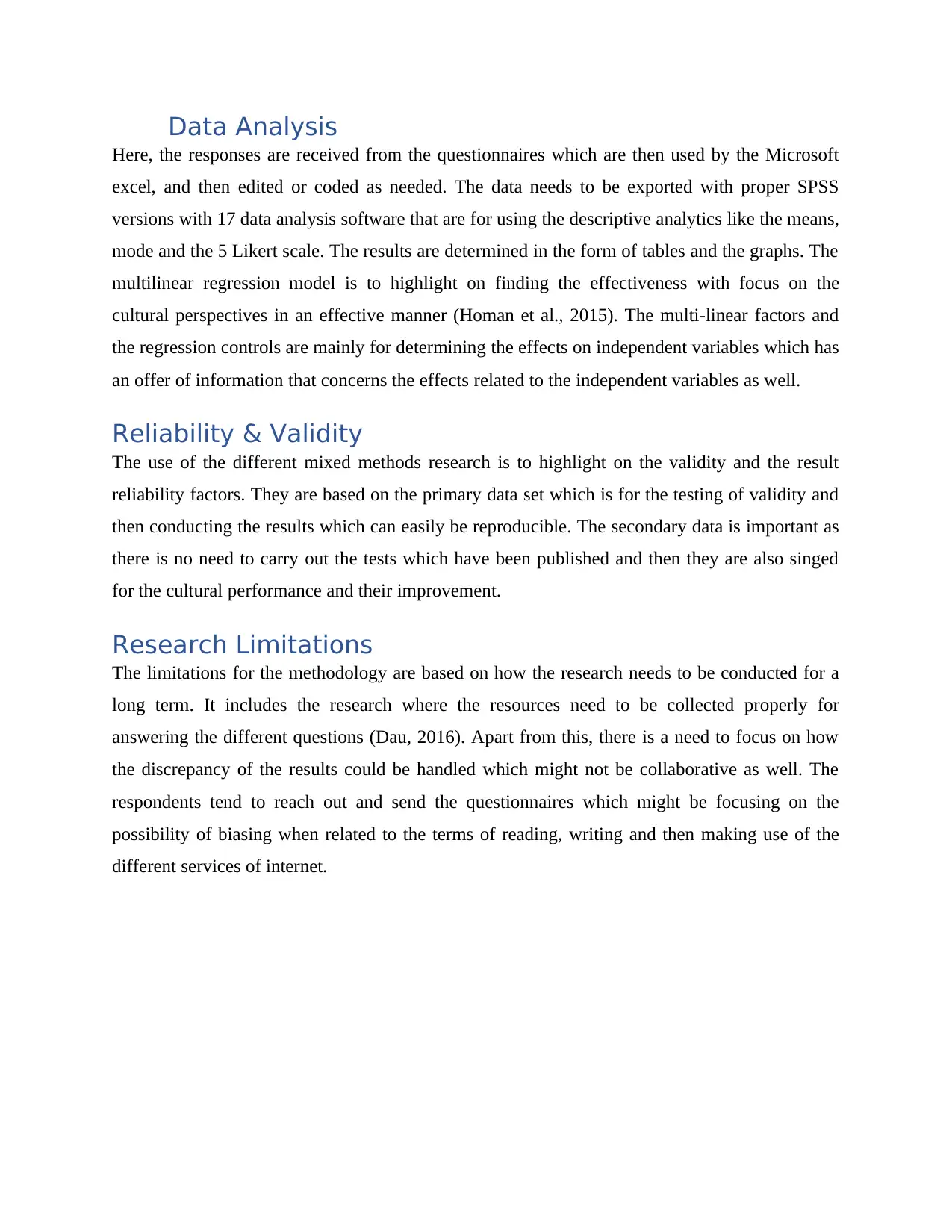
Data Analysis
Here, the responses are received from the questionnaires which are then used by the Microsoft
excel, and then edited or coded as needed. The data needs to be exported with proper SPSS
versions with 17 data analysis software that are for using the descriptive analytics like the means,
mode and the 5 Likert scale. The results are determined in the form of tables and the graphs. The
multilinear regression model is to highlight on finding the effectiveness with focus on the
cultural perspectives in an effective manner (Homan et al., 2015). The multi-linear factors and
the regression controls are mainly for determining the effects on independent variables which has
an offer of information that concerns the effects related to the independent variables as well.
Reliability & Validity
The use of the different mixed methods research is to highlight on the validity and the result
reliability factors. They are based on the primary data set which is for the testing of validity and
then conducting the results which can easily be reproducible. The secondary data is important as
there is no need to carry out the tests which have been published and then they are also singed
for the cultural performance and their improvement.
Research Limitations
The limitations for the methodology are based on how the research needs to be conducted for a
long term. It includes the research where the resources need to be collected properly for
answering the different questions (Dau, 2016). Apart from this, there is a need to focus on how
the discrepancy of the results could be handled which might not be collaborative as well. The
respondents tend to reach out and send the questionnaires which might be focusing on the
possibility of biasing when related to the terms of reading, writing and then making use of the
different services of internet.
Here, the responses are received from the questionnaires which are then used by the Microsoft
excel, and then edited or coded as needed. The data needs to be exported with proper SPSS
versions with 17 data analysis software that are for using the descriptive analytics like the means,
mode and the 5 Likert scale. The results are determined in the form of tables and the graphs. The
multilinear regression model is to highlight on finding the effectiveness with focus on the
cultural perspectives in an effective manner (Homan et al., 2015). The multi-linear factors and
the regression controls are mainly for determining the effects on independent variables which has
an offer of information that concerns the effects related to the independent variables as well.
Reliability & Validity
The use of the different mixed methods research is to highlight on the validity and the result
reliability factors. They are based on the primary data set which is for the testing of validity and
then conducting the results which can easily be reproducible. The secondary data is important as
there is no need to carry out the tests which have been published and then they are also singed
for the cultural performance and their improvement.
Research Limitations
The limitations for the methodology are based on how the research needs to be conducted for a
long term. It includes the research where the resources need to be collected properly for
answering the different questions (Dau, 2016). Apart from this, there is a need to focus on how
the discrepancy of the results could be handled which might not be collaborative as well. The
respondents tend to reach out and send the questionnaires which might be focusing on the
possibility of biasing when related to the terms of reading, writing and then making use of the
different services of internet.
Paraphrase This Document
Need a fresh take? Get an instant paraphrase of this document with our AI Paraphraser
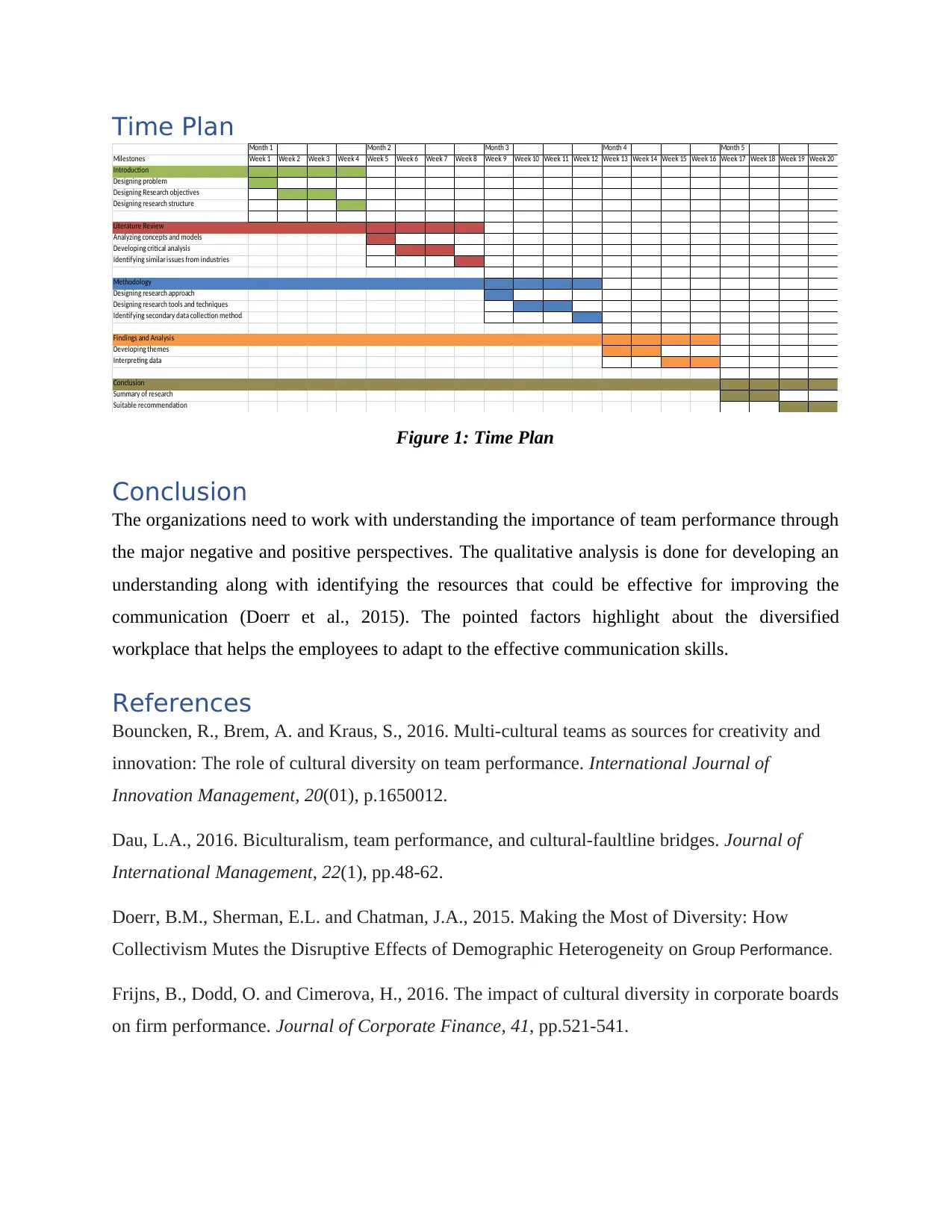
Time Plan Month 1 Month 2 Month 3 Month 4 Month 5
Milestones Week 1 Week 2 Week 3 Week 4 Week 5 Week 6 Week 7 Week 8 Week 9 Week 10 Week 11 Week 12 Week 13 Week 14 Week 15 Week 16 Week 17 Week 18 Week 19 Week 20
Introduction
Designing problem
Designing Research objectives
Designing research structure
Literature Review
Analyzing concepts and models
Developing critical analysis
Identifying similar issues from industries
Methodology
Designing research approach
Designing research tools and techniques
Identifying secondary data collection method
Findings and Analysis
Developing themes
Interpreting data
Conclusion
Summary of research
Suitable recommendation
Figure 1: Time Plan
Conclusion
The organizations need to work with understanding the importance of team performance through
the major negative and positive perspectives. The qualitative analysis is done for developing an
understanding along with identifying the resources that could be effective for improving the
communication (Doerr et al., 2015). The pointed factors highlight about the diversified
workplace that helps the employees to adapt to the effective communication skills.
References
Bouncken, R., Brem, A. and Kraus, S., 2016. Multi-cultural teams as sources for creativity and
innovation: The role of cultural diversity on team performance. International Journal of
Innovation Management, 20(01), p.1650012.
Dau, L.A., 2016. Biculturalism, team performance, and cultural-faultline bridges. Journal of
International Management, 22(1), pp.48-62.
Doerr, B.M., Sherman, E.L. and Chatman, J.A., 2015. Making the Most of Diversity: How
Collectivism Mutes the Disruptive Effects of Demographic Heterogeneity on Group Performance.
Frijns, B., Dodd, O. and Cimerova, H., 2016. The impact of cultural diversity in corporate boards
on firm performance. Journal of Corporate Finance, 41, pp.521-541.
Milestones Week 1 Week 2 Week 3 Week 4 Week 5 Week 6 Week 7 Week 8 Week 9 Week 10 Week 11 Week 12 Week 13 Week 14 Week 15 Week 16 Week 17 Week 18 Week 19 Week 20
Introduction
Designing problem
Designing Research objectives
Designing research structure
Literature Review
Analyzing concepts and models
Developing critical analysis
Identifying similar issues from industries
Methodology
Designing research approach
Designing research tools and techniques
Identifying secondary data collection method
Findings and Analysis
Developing themes
Interpreting data
Conclusion
Summary of research
Suitable recommendation
Figure 1: Time Plan
Conclusion
The organizations need to work with understanding the importance of team performance through
the major negative and positive perspectives. The qualitative analysis is done for developing an
understanding along with identifying the resources that could be effective for improving the
communication (Doerr et al., 2015). The pointed factors highlight about the diversified
workplace that helps the employees to adapt to the effective communication skills.
References
Bouncken, R., Brem, A. and Kraus, S., 2016. Multi-cultural teams as sources for creativity and
innovation: The role of cultural diversity on team performance. International Journal of
Innovation Management, 20(01), p.1650012.
Dau, L.A., 2016. Biculturalism, team performance, and cultural-faultline bridges. Journal of
International Management, 22(1), pp.48-62.
Doerr, B.M., Sherman, E.L. and Chatman, J.A., 2015. Making the Most of Diversity: How
Collectivism Mutes the Disruptive Effects of Demographic Heterogeneity on Group Performance.
Frijns, B., Dodd, O. and Cimerova, H., 2016. The impact of cultural diversity in corporate boards
on firm performance. Journal of Corporate Finance, 41, pp.521-541.
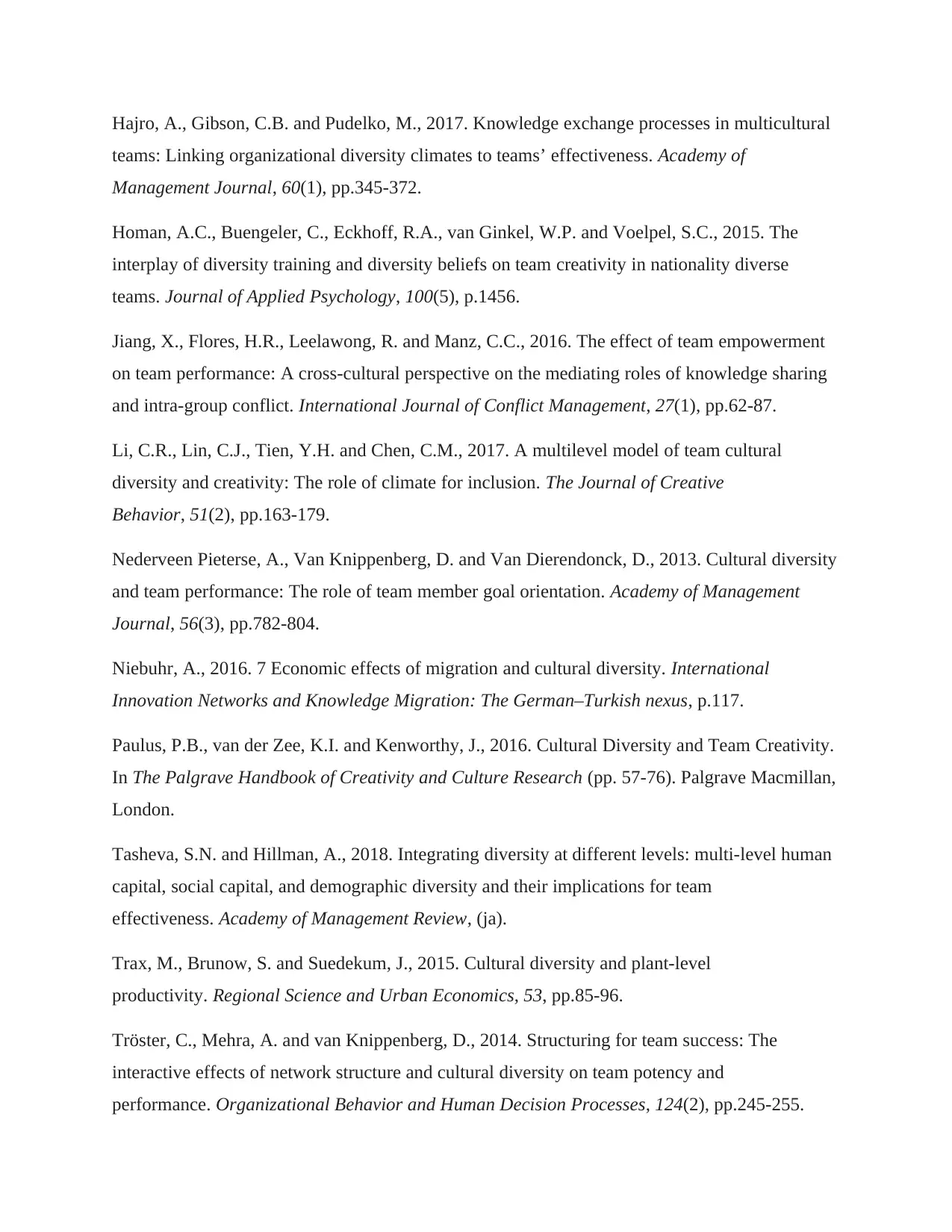
Hajro, A., Gibson, C.B. and Pudelko, M., 2017. Knowledge exchange processes in multicultural
teams: Linking organizational diversity climates to teams’ effectiveness. Academy of
Management Journal, 60(1), pp.345-372.
Homan, A.C., Buengeler, C., Eckhoff, R.A., van Ginkel, W.P. and Voelpel, S.C., 2015. The
interplay of diversity training and diversity beliefs on team creativity in nationality diverse
teams. Journal of Applied Psychology, 100(5), p.1456.
Jiang, X., Flores, H.R., Leelawong, R. and Manz, C.C., 2016. The effect of team empowerment
on team performance: A cross-cultural perspective on the mediating roles of knowledge sharing
and intra-group conflict. International Journal of Conflict Management, 27(1), pp.62-87.
Li, C.R., Lin, C.J., Tien, Y.H. and Chen, C.M., 2017. A multilevel model of team cultural
diversity and creativity: The role of climate for inclusion. The Journal of Creative
Behavior, 51(2), pp.163-179.
Nederveen Pieterse, A., Van Knippenberg, D. and Van Dierendonck, D., 2013. Cultural diversity
and team performance: The role of team member goal orientation. Academy of Management
Journal, 56(3), pp.782-804.
Niebuhr, A., 2016. 7 Economic effects of migration and cultural diversity. International
Innovation Networks and Knowledge Migration: The German–Turkish nexus, p.117.
Paulus, P.B., van der Zee, K.I. and Kenworthy, J., 2016. Cultural Diversity and Team Creativity.
In The Palgrave Handbook of Creativity and Culture Research (pp. 57-76). Palgrave Macmillan,
London.
Tasheva, S.N. and Hillman, A., 2018. Integrating diversity at different levels: multi-level human
capital, social capital, and demographic diversity and their implications for team
effectiveness. Academy of Management Review, (ja).
Trax, M., Brunow, S. and Suedekum, J., 2015. Cultural diversity and plant-level
productivity. Regional Science and Urban Economics, 53, pp.85-96.
Tröster, C., Mehra, A. and van Knippenberg, D., 2014. Structuring for team success: The
interactive effects of network structure and cultural diversity on team potency and
performance. Organizational Behavior and Human Decision Processes, 124(2), pp.245-255.
teams: Linking organizational diversity climates to teams’ effectiveness. Academy of
Management Journal, 60(1), pp.345-372.
Homan, A.C., Buengeler, C., Eckhoff, R.A., van Ginkel, W.P. and Voelpel, S.C., 2015. The
interplay of diversity training and diversity beliefs on team creativity in nationality diverse
teams. Journal of Applied Psychology, 100(5), p.1456.
Jiang, X., Flores, H.R., Leelawong, R. and Manz, C.C., 2016. The effect of team empowerment
on team performance: A cross-cultural perspective on the mediating roles of knowledge sharing
and intra-group conflict. International Journal of Conflict Management, 27(1), pp.62-87.
Li, C.R., Lin, C.J., Tien, Y.H. and Chen, C.M., 2017. A multilevel model of team cultural
diversity and creativity: The role of climate for inclusion. The Journal of Creative
Behavior, 51(2), pp.163-179.
Nederveen Pieterse, A., Van Knippenberg, D. and Van Dierendonck, D., 2013. Cultural diversity
and team performance: The role of team member goal orientation. Academy of Management
Journal, 56(3), pp.782-804.
Niebuhr, A., 2016. 7 Economic effects of migration and cultural diversity. International
Innovation Networks and Knowledge Migration: The German–Turkish nexus, p.117.
Paulus, P.B., van der Zee, K.I. and Kenworthy, J., 2016. Cultural Diversity and Team Creativity.
In The Palgrave Handbook of Creativity and Culture Research (pp. 57-76). Palgrave Macmillan,
London.
Tasheva, S.N. and Hillman, A., 2018. Integrating diversity at different levels: multi-level human
capital, social capital, and demographic diversity and their implications for team
effectiveness. Academy of Management Review, (ja).
Trax, M., Brunow, S. and Suedekum, J., 2015. Cultural diversity and plant-level
productivity. Regional Science and Urban Economics, 53, pp.85-96.
Tröster, C., Mehra, A. and van Knippenberg, D., 2014. Structuring for team success: The
interactive effects of network structure and cultural diversity on team potency and
performance. Organizational Behavior and Human Decision Processes, 124(2), pp.245-255.
⊘ This is a preview!⊘
Do you want full access?
Subscribe today to unlock all pages.

Trusted by 1+ million students worldwide
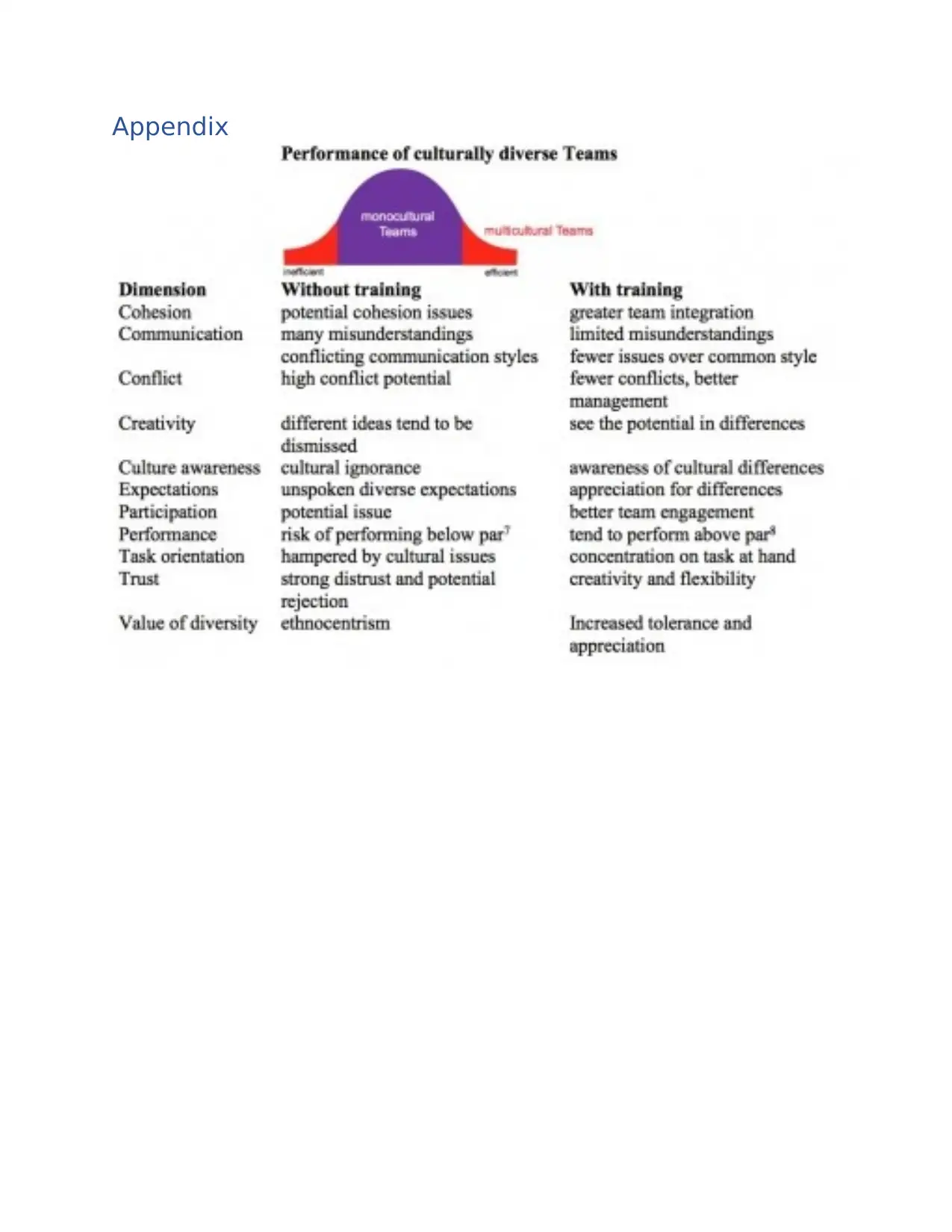
Appendix
1 out of 10
Related Documents
Your All-in-One AI-Powered Toolkit for Academic Success.
+13062052269
info@desklib.com
Available 24*7 on WhatsApp / Email
![[object Object]](/_next/static/media/star-bottom.7253800d.svg)
Unlock your academic potential
Copyright © 2020–2025 A2Z Services. All Rights Reserved. Developed and managed by ZUCOL.




